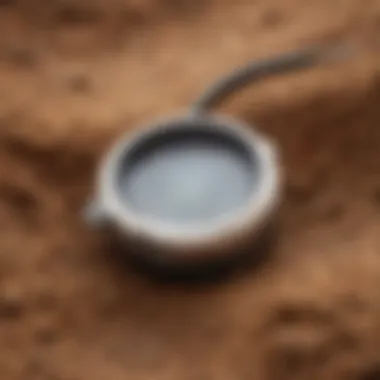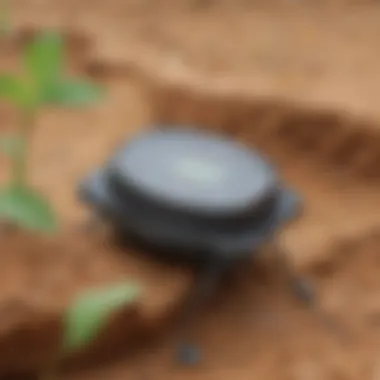Strategies for Optimizing Humidity Sensors Against Dirt Accumulation Challenges


Science Fun Facts
Humidity sensors have a meticulous role in monitoring moisture levels accurately in various environments. Did you know that dirt accumulation can significantly impact humidity sensor performance? The interaction between dirt particles and sensor components can skew readings and compromise data accuracy, making maintenance crucial for optimal functionality.
Strategies for Dirt Resistance
Discovering ways to shield humidity sensors from dirt buildup is essential for ensuring long-term precision. By implementing protective measures such as filters or coatings, sensors can maintain sensitivity and responsiveness even in dusty conditions. Understanding the dynamics between dirt particles and sensor surfaces is fundamental to devising effective strategies for dirt resilience.
Discover the Wonders of Science
Exploring the scientific principles behind humidity sensor technology unveils a world of innovation and precision engineering. Dive into the fascinating realm of sensor design, where intricate mechanisms interact seamlessly to capture and interpret moisture levels accurately. Witness the marriage of science and technology in creating cutting-edge sensing solutions for diverse applications.
Applications in Real-World Settings
Humidity sensors play a pivotal role in numerous industries, from HVAC systems to agricultural automation. By tracking and controlling moisture levels with remarkable precision, these sensors enable optimized operation and enhanced efficiency. Explore the varied applications of humidity sensors in everyday life and appreciate their significance in modern technological advancements.
Introduction
Understanding Humidity Sensors
Types of Humidity Sensors
When delving into the diverse landscape of humidity sensors, one encounters various types, each with unique characteristics and functionalities. These types include capacitive, resistive, and thermal conductivity sensors, among others. The capacitive humidity sensor stands out for its high accuracy and reliability, making it a preferred choice in environments where precise moisture measurement is crucial. Despite its advantages, such as rapid response times and low costs, the capacitive sensor may be susceptible to drift over time, necessitating recalibration. On the other hand, resistive humidity sensors offer robust performance in harsh conditions at the expense of accuracy. Understanding the strengths and limitations of each type is vital for selecting the most suitable sensor for a specific application.
Principles of Operation
The principles governing the operation of humidity sensors are as diverse as the sensors themselves. Whether utilizing changes in electrical capacitance, resistance, or thermal conductivity to measure humidity levels, sensor operation is intricately linked to the physical properties of moisture. For instance, capacitive sensors rely on changes in capacitance due to moisture absorption, offering a precise and dynamic measurement method. In contrast, resistive sensors detect humidity through changes in resistance, providing a stronger signal in harsh environments. By grasping the operational principles of humidity sensors, users can make informed decisions regarding sensor selection and calibration to ensure accurate and reliable data capture.


Challenges of Dirt Accumulation
Dive deeply into the critical aspect of challenges posed by dirt accumulation in the realm of humidity sensors. This section delves into the intricate dynamics of how dirt can impact sensor performance and longevity. By highlighting the significance of combating dirt accumulation, we shed light on the essential strategies needed to optimize humidity sensor functionality under adverse conditions. Understanding the challenges of dirt accumulation is paramount for anyone seeking to maximize the efficiency and accuracy of humidity sensors in real-world applications.
Effects on Sensor Accuracy
Impact on Readings
Unveil the specific implications of dirt accumulation on sensor readings and its pivotal role in determining the overall accuracy of humidity sensors. Explore the nuances of how dirt can skew readings and distort the sensor's ability to provide precise measurements. This section extensively covers the distinctive characteristic of how dirt impacts readings, shedding light on why mitigating this factor is crucial for maintaining sensor reliability. By delving into the unique features of how dirt affects readings, we can comprehend its advantages or disadvantages in optimizing humidity sensor performance in varied environmental settings.
Degradation of Sensing Elements
Delve into the gradual deterioration of sensing elements due to dirt accumulation and its profound impact on sensor functionality. Highlight the key characteristics of how dirt contributes to the degradation of sensor elements, emphasizing why addressing this phenomenon is vital within the context of this article. Discuss the distinctive features associated with the degradation of sensing elements caused by dirt and elucidate the advantages or disadvantages of encountering such challenges in optimizing humidity sensor longevity and accuracy.
Strategies for Dirt Resistance
Sensor Encapsulation
In the realm of Sensor Encapsulation, Hydrophobic Coatings and Particle Filters stand out as key components essential for safeguarding humidity sensors against dirt infiltration and subsequent degradation. Hydrophobic coatings serve as a protective barrier, repelling water and contaminants to maintain sensor accuracy over time. Their nonstick properties make them a popular choice for applications requiring dirt resistance. However, it is important to note that Hydrophobic Coatings may have limitations in extreme conditions, compelling the need for additional protective measures.
When it comes to Particle Filters, their function revolves around trapping and blocking particulate matter from entering the sensor, thus preventing interference with sensing elements. The unique feature of Particle Filters lies in their ability to remain effective even in high-contaminant environments, ensuring prolonged sensor functionality. Despite their efficacy, users should remain attentive to the potential restriction of airflow and regular maintenance requirements associated with Particle Filters.
Sealing Techniques
Within the domain of Sealing Techniques, Epoxy Encapsulation and Potting Compounds emerge as indispensable methods for fortifying humidity sensors against dirt ingress. Epoxy Encapsulation provides a robust shield around the sensor, enhancing its resistance to environmental factors such as dust and moisture. The key characteristic of Epoxy Encapsulation lies in its ability to form a seamless protective layer, safeguarding sensor components from external pollutants. While offering significant benefits in terms of durability, users should be mindful of the curing time and potential challenges associated with rework.
Conversely, Potting Compounds excel in creating a secure barrier that seals the sensor from dirt and humidity. Their flexibility and adaptability make them a preferred choice for applications requiring resilience to varying environmental conditions. The unique feature of Potting Compounds lies in their ability to conform to irregular shapes, ensuring comprehensive sensor protection. Users should take note of proper mixing ratios and curing conditions to maximize the effectiveness of Potting Compounds.


Cleaning and Maintenance
In the realm of Cleaning and Maintenance, Regular Inspection and Dust Removal Procedures play a pivotal role in preserving sensor functionality amidst dirt exposure. Regular Inspection involves scheduled assessments of sensor condition to detect any signs of contamination or wear, enabling timely intervention to prevent performance issues. The key characteristic of Regular Inspection is its proactive nature, allowing users to address potential problems before they escalate.
On the other hand, Dust Removal Procedures encompass methods for safely eliminating accumulated dirt and debris from sensor surfaces. This essential maintenance task ensures unhindered sensor operation by clearing obstructions that could impede accurate readings. The unique feature of Dust Removal Procedures lies in their simplicity and effectiveness, offering a cost-efficient way to extend the lifespan of humidity sensors. However, users should exercise caution to avoid damaging sensor components during cleaning processes.
Advanced Calibration Methods
Auto-Compensation Algorithms
Adaptive Filtering
Auto-compensation algorithms, particularly adaptive filtering, stand out as essential components in the calibration arsenal of humidity sensors. Adaptive filtering allows sensors to adapt to changing environmental factors by continuously analyzing input data and making real-time adjustments. The key characteristic of adaptive filtering lies in its ability to 'learn' from past experiences, refining its output based on historical data patterns. This adaptive nature makes it a popular choice for optimizing sensor accuracy in dynamic conditions. However, challenges may arise in balancing adaptability with stability, as overcorrection can lead to oscillations or inaccuracies in readings, highlighting the delicate balance required in implementing adaptive filtering.
Temperature Compensation
Temperature compensation represents a critical feature in advanced calibration methods for humidity sensors. By accounting for temperature variations, sensors can provide more precise readings regardless of environmental influences. The key characteristic of temperature compensation lies in its ability to adjust humidity measurements based on temperature changes, ensuring data integrity and reliability. This feature is particularly beneficial in applications where temperature fluctuations are significant, as it helps maintain consistency in sensor performance. However, challenges may arise in accurately calibrating the temperature compensation algorithm to account for complex interactions between temperature and humidity, requiring meticulous fine-tuning to achieve optimal results.
Dynamic Calibration Techniques
Real-Time Adjustments
Dynamic calibration techniques, exemplified by real-time adjustments, introduce a proactive approach to humidity sensor optimization. By continuously monitoring sensor performance and environmental conditions, real-time adjustments enable immediate corrections to optimize accuracy and reliability. The key characteristic of real-time adjustments is their responsiveness to sudden changes, allowing for swift adaptations to maintain data precision. This agility makes real-time adjustments a popular choice for applications requiring rapid response times and precise humidity control. Nevertheless, implementing real-time adjustments requires robust sensor infrastructure and software support to ensure seamless integration and effective operation.
Integration with Environmental Data
Integrating humidity sensors with environmental data expands the horizons of calibration techniques, offering a holistic approach to optimizing sensor performance. By incorporating external data sources such as temperature, pressure, and air quality, sensors can enhance their calibration algorithms and decision-making capabilities. The key characteristic of integration with environmental data is the synergy achieved by combining multiple variables to refine sensor output. This comprehensive approach not only boosts sensor accuracy but also facilitates informed insights into the overall environmental conditions. However, challenges may arise in data synchronization and interpretation, emphasizing the need for advanced algorithms and data processing techniques to extract meaningful correlations and ensure reliable sensor operation.


Optimization of Humidity Sensors for Resistantirt
The subject of humidity sensor optimization for dirt resistance is a critical aspect within the realm of sensor technology. In this section, we will delve deep into strategies and methods aimed at enhancing the durability and accuracy of humidity sensors in challenging environments. Through meticulous analyses and innovative approaches, the goal is to maximize sensor performance under conditions where dirt accumulation poses a significant threat.
Importance of Case Studies and Practical Applications
Smart Agriculture Systems
Smart agriculture systems integrate advanced technologies like humidity sensors to revolutionize farming practices. Within this context, irrigation control plays a pivotal role in managing water resources efficiently. By incorporating precise humidity measurements, irrigation control systems can adjust water levels based on real-time data, optimizing plant growth and resource utilization. The strategic placement of sensors enables farmers to monitor soil moisture levels accurately, facilitating informed decisions regarding irrigation schedules.
Irrigation Control
The meticulous monitoring and regulation of water supply, irrigation control is crucial for maximizing crop yields and conserving water resources. By leveraging humidity sensors, farmers can implement precise irrigation strategies tailored to the specific moisture needs of crops, thereby enhancing overall agricultural productivity. The versatility of irrigation control lies in its ability to adapt to varying soil conditions, ensuring optimal moisture levels for plant growth while minimizing water wastage.
Crop Monitoring
Crop monitoring, facilitated by humidity sensors, offers invaluable insights into plant health and growth patterns. Through continuous data collection, farmers can track factors such as temperature, humidity, and soil moisture, enabling early detection of plant stress or disease outbreaks. This proactive approach allows for timely interventions and adjustments in cultivation practices, fostering healthier crops and maximizing yields.
Industrial Automation
In the realm of industrial automation, humidity sensors play a critical role in ensuring optimal operational efficiency and product quality. Processes such as process control rely on accurate humidity measurements to maintain controlled environments and regulate manufacturing variables. By integrating humidity sensors into automated systems, industries can uphold stringent quality standards while optimizing production processes.
Process Control
Process control entails the precise management of manufacturing processes to achieve desired output quality and consistency. By utilizing humidity sensors, industries can monitor and adjust environmental conditions to meet specific operational requirements. The integration of humidity data enables real-time adjustments, enhancing process control capabilities and minimizing deviations in product quality.
HVAC Systems
HVAC systems rely on humidity sensors to maintain indoor air quality and comfort levels in commercial and residential settings. By incorporating humidity sensing technology, HVAC systems can regulate humidity levels to prevent mold growth, enhance occupant comfort, and improve energy efficiency. The seamless integration of humidity sensors into HVAC systems ensures optimal performance and environmental comfort for occupants.
HVAC Systems
HVAC systems necessitate accurate humidity control to ensure indoor comfort and air quality. By embedding humidity sensors, HVAC systems can detect and adjust moisture levels to prevent mold proliferation and maintain ideal living conditions. The intrinsic feature of humidity sensors in HVAC systems lies in their capacity to enhance energy efficiency and create a healthier indoor environment.







